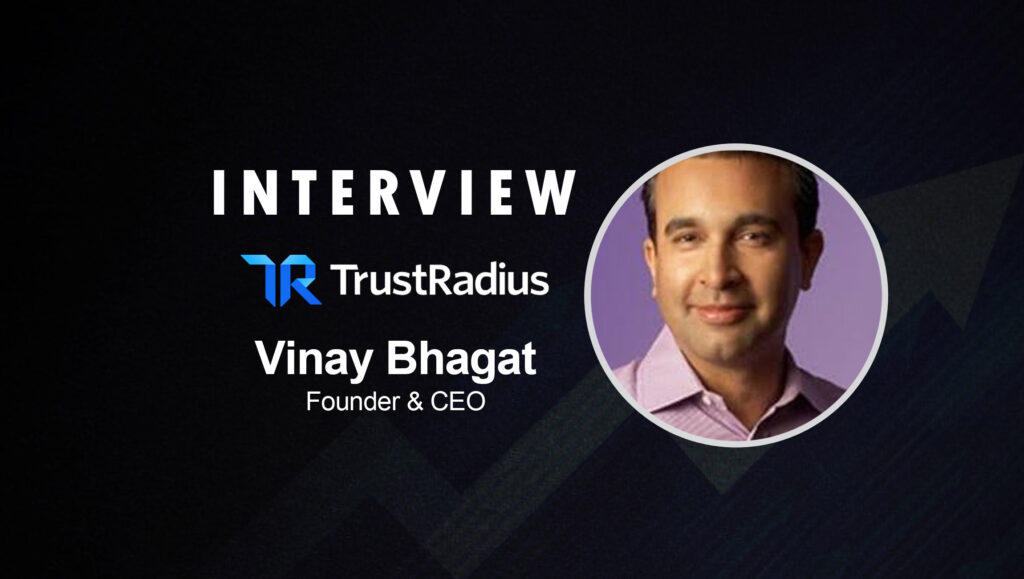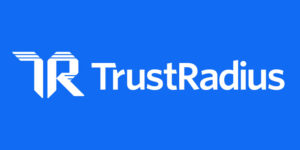Create trust quickly through digital channels during this global pandemic suggests Vinay Bhagat, tech entrepreneur and CEO/Founder of TrustRadius, a trusted customer voice and insights platform that helps tech buyers make better decisions based on peer reviews. Catch the complete QnA where Vinay shares his thoughts on the impact of Covid-19 in the tech / B2B sales marketplace and how the team at TrustRadius responded to the global pandemic.
____
Can you tell us a little about yourself Vinay? How did the story and idea behind TrustRadius first come about?
I’m a repeat entrepreneur. My first company, Convio was an early SaaS company which helped nonprofits drive fundraising and advocacy on the Web. We built the company to $80m in revenue, helped charities raise $billions a year, went public on NASDAQ in 2010 and were acquired for $325m in 2012.
I conceived TrustRadius in 2012 while witnessing first-hand the challenges of procuring software at Convio. We bought an expensive HR system, rolled it out to our company, and then discovered it was a poor functional fit. The product was a leader in the Gartner MQ. Our HR team had validated their requirements with the salesperson and talked to vendor supplied references. Yet we still made a costly mistake. We learned that it’s critical to talk to people who share your use case. At the same time I was buying a high end coffee machine. I found an online community called CoffeeGeek that had incredibly in-depth reviews written by coffee mavens. I wondered why no one had created something similar to support enterprise technology decisions which are far more complex.
Read More: Digital Leapfrogging: Is Your Online Business About To Get Jumped?
Tell us about TrustRadius as it is today, and how the journey has been since starting up?
TrustRadius has become the trusted customer review platform for B2B technology. We help >1 million tech buyers each month make confident decisions. Our audience is global and 50% are from enterprises >1k employees. Because of the depth of our content, buyers spend upwards of 11 minutes on our comparison pages alone.
We help leading tech brands like Cisco, IBM, SAP, Oracle and many high growth start-ups activate their customers to write reviews influential with buyers, harness the authentic voice of customers in their own channels to improve conversion and to provide rich feedback and insights. Over time we’ve become a data first company, capturing amazing insights into buyer behavior that help brands improve their marketing efficiency. We help brands focus their advertising on in-market buyers and provide intelligence about which companies are considering their product or competitors. We call that True Intent.
From the onset I knew I wanted to build TrustRadius differently to Convio. I aimed to raise less capital, drive a more efficient business model, and to realize the network effects of a two-sided marketplace. I bootstrapped for the first year, building a private beta to validate the idea. I then raised a $5 million series A from the Mayfield fund in July 2013. We were Mayfield’s first investment in Texas. I’d known the investing partner Rajeev Batra for almost a decade. We later went on to raise two more moderate sized rounds, totalling $25m in cumulative capital, again from investors that I’ve worked with before. I’ve learned that you need to pick your VCs based upon trust and value add first and foremost.
We’ve been very methodical and disciplined in building the business. Growing a start-up is more often a marathon than a sprint and it’s important to nail the fundamentals before you scale. We spent our first year post funding figuring out how to drive high quality reviews at scale. Choosing enterprise software is not the same as choosing a restaurant on Yelp. We also created foundational measures to ensure trustworthiness – how we vetted reviews, and ensured scores could not be manipulated. To this day, we’re the only technology review platform that controls for ratings bias. We spent 4 years building our site and content base before we even attempted to monetize our platform.
When it came to monetization, we made the decision early on not to monetize the buyer. We believed it would create friction to adoption. Instead, we sought to monetize vendors but in a way that wouldn’t be “pay to play” and degrade buyer trust. The incumbent software directory platforms were very much “pay to play”. Your positioning in their lists is based upon what you’re willing to pay per lead. I wanted to build a very different platform. One that was built from the ground up to be the trusted advice platform. We’ve achieved that goal. Today, the average buyer spends over 11 minutes each time they visit one of our comparison pages. Google has rewarded our focus on quality, and we have grown our audience 2.4x in the last year. We’ve taken a very different and frankly harder path than our competitors, but it’s starting to pay dividends.
How has the ongoing Covid-19 pandemic changed how you and your team have redefined your sales / marketing processes or core business strategies? How would you sum up business in pre-Covid days and business-as-it-is-today?
When Covid-19 hit, our first move like many companies was to freeze hiring, cut discretionary expenses with a goal to survive and avoid layoffs. The second thing we did was to get even closer to our customers. I reached out personally to many and instructed our team to make sure we were doing everything we could to help. We created a daily internal review meeting with a different Customer Service Manager (CSM) each day to review adoption at their customers. We improved our methodologies and systems for tracking account health and planning and built a 4 quarter rolling forecast for gross retention. We promoted our strongest CSM into an overlay role to help up-level our approach to guiding customers across our team. We created a tiered model of engagement to make sure that our largest customers had a very high touch experience. That work has paid dividends. Not only did we stave off the risk from increased churn from Covid-19, but we’ve beaten our gross retention plan set before Covid.
From a sales perspective, we also increased focus on current customers. In a pandemic, it’s much easier to expand happy existing customers versus add new ones. We work with some of the largest tech companies in the world, many of whom have 10s-100s of product lines / divisions. We’ve had tremendous success expanding our footprint, often squeezing out competitors. Our enterprise audience, high engagement and in-depth content have proven to be important differentiators. This strategy led us to our first multi-million dollar deal.
We also revisited our messaging to make sure it was contextually relevant, upgrading our vendor facing website, and enabling our sales team to talk about our audience strength. We’ve grown our audience 2.4x in the last 12 months and are now #1 in many categories. Lastly, we redeployed our event marketing lead into a customer marketing role. We have amazing customer stories to tell, and it required full time focus.
Like many, we experienced a hit in pipeline generation when Covid hit. My viewpoint was we have to become absolute masters of our craft. We dug in deep into our metrics, and rethought all facets of our operations. We redesigned our outbound cadences, offers and channel mix. We redirected one of our BDRs to focus on opening new avenues in existing large accounts. We hired a new director of growth who is taking a much more analytical and CRO focused approach to demand generation.
Read More: TrustRadius Exceeds First Half Growth Targets, Achieves Significant Enterprise Traction
The net result is that we achieved 164% of our Q2 board plan set pre-Covid, and 118% of our 1H plan, all with far fewer resources than planned. We believe we did many things right operationally but also that Covid and everyone working from home has made the need for TrustRadius more acute. Without face to face contact, brands struggle to invoke trust with buyers. We activate their customers to speak for them. The buyer’s journey is now 100% digital and a lot of buyer’s research is now done on platforms like ours. Lastly, it’s really hard for brands to discern true purchase intent without the in person interactions of sales meetings and events. We provide high quality intent data that’s highly predictive.
How would you advise B2B and tech sales teams to revisit their overall sales processes and sales outlook during a global downtime caused by a health pandemic?
There’s no one size fits all right answer. It’s going to depend on the context of your market. In general, my first guidance is to get really close to existing customers – both to retain them, but then also to look for expansion opportunities. The second step is to refine your messaging, your offer and in time your product to be as hyper relevant as you can for the new market. The third step is to extend your visibility for forecasting as far as possible – track conversion rates at every stage, by channel, by customer type and delineate new logos versus expansions. We’re now able to forecast gross retention (renewals) four quarters out. It’s a moving target of course, but it gives us some confidence in planning. We’re trying to get much more predictive in sales too. Today, we generally have a strong view into the next quarter midway through a quarter, and we’re trying hard to extend that visibility.
During a time such as this – how would you advise sales/marketing teams to capitalize on product reviews and user ratings in tech / b2b to help build better prospect relationships?
Product reviews have become more relevant than ever before. Buyers are unable to get peer insights from interactions at events, and have moved their research process 100% online. So at minimum it’s important to be present in the venues that attract and influence your audience. For most companies that does mean a multi-site strategy, but you don’t need to boil the ocean – pick 2-3 sites that are most influential in your category and with your ICP (ideal customer profile). Don’t be fooled by vanity metrics for gross traffic figures that are inflated by covering categories irrelevant to yours or by large blog sites.
Establishing trust with buyers has become more important than ever. Buyers have a fundamental mistrust of sales and marketing. Harnessing quotes and data from reviews in your own channels is a good way to invoke trust with buyers. One simple approach is to syndicate quotes from reviews to your web pages, and conversion oriented landing pages.
What are some of the ways in which you still see marketing and sales teams in tech not utilizing the full capability of their sales and marketing automation to target the right clients at the right time…how would you tell them to address this? More so, how would you advise them to optimize their martech / salestech further to beat common business challenges arising as a result of the Covid-19 spread.
A big opportunity in sales and marketing today is engaging active buyers based upon their purchase intent. While there’s a lot of talk about intent data, very few companies are using it strategically to advance their organizations. Moreover, not all intent data is created equal. Some is just an indication of high level interest vs. an indication of true purchase intent. TrustRadius provides three mechanisms to engage high intent buyers. First, by growing a review presence on our site, you increase your visibility in your product category and capture . Second, we enable brands to advertise outside of our site to high intent buyers in their category who have been actively researching products on our site. Third we provide intelligence we call True Intent that
In a challenging environment due to the Covid19 pandemic: what are some of the ways in which you as a leader are enabling a balanced remote work culture while maintaining motivation levels?
One of the simple measures we’ve taken is to institute a once a month self-care day – paid day off, for every employee. We also have a flexible work policy focused on outcomes versus when you work. Some of our employees are caregivers and with children at home, some have needed more flexibility in their schedule. Another important thing we’ve done is make sure we have a close pulse on our employees. We use a tool called 15Five to both measure our progress against OKRs, but also to get a weekly pulse on how everyone is feeling. I read everyone’s 15Five each week and it influences my thinking on how we need to act.
Read More: SalesTechStar Interview With William Tyree, Chief Marketing Officer At RingDNA
Catch some of our conversations on the State of Sales, Marketing and Working In Tech from these episodes of The SalesStar Podcast –Featuring leaders from Acoustic, CloudShare, Qumulo and more. Listen Now!
TrustRadius is the fastest growing, most trusted customer voice and insights platform that helps tech buyers make great decisions and helps technology vendors acquire and retain great customers. Each month, over 1 million B2B technology buyers use verified reviews and ratings on TrustRadius.com to make informed purchasing decisions. Headquartered in Austin, TX, TrustRadius was founded by successful entrepreneurs and is backed by Next Coast Ventures, Mayfield Fund, and LiveOak Venture Partners.
Vinay is the CEO/Founder of TrustRadius























